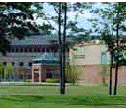






















|
|
Particle Deposition Mechanisms Mass Diffusion
Table 8: Particle mass diffusivity. The mean-square displacement for a Brownian particle is given as
Brownian Motion of Rotation Aerosol particles may also rotate randomly due to the Brownian effects. The mean-square angle of rotation is given as
Distributions When the gas is in equilibrium, the aerosol particle will have the same average translational energy as molecules. Thus
and the root-mean-square particle velocity is given by
Under equilibrium, aerosol particles will have a Maxwellian distribution and their concentration in a gravitational field is given by
|


|




 10-4
10-4 (one-dim)
(one-dim)



